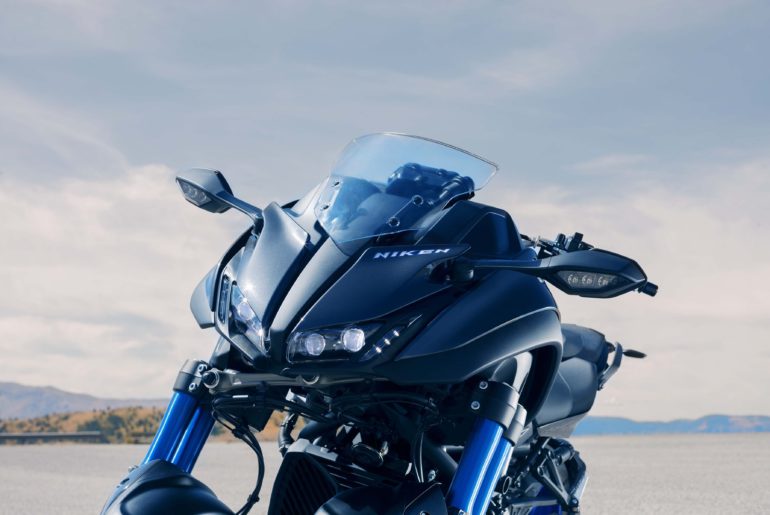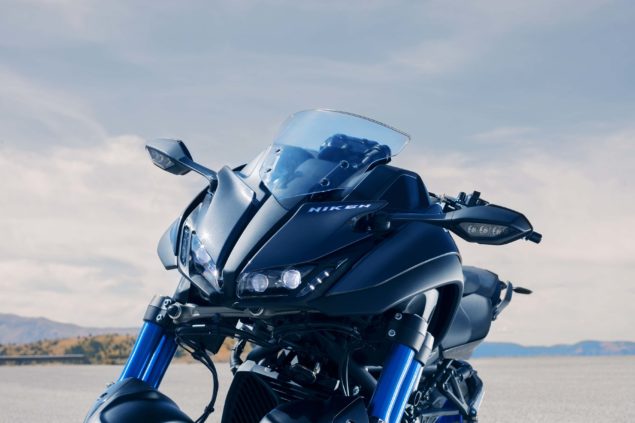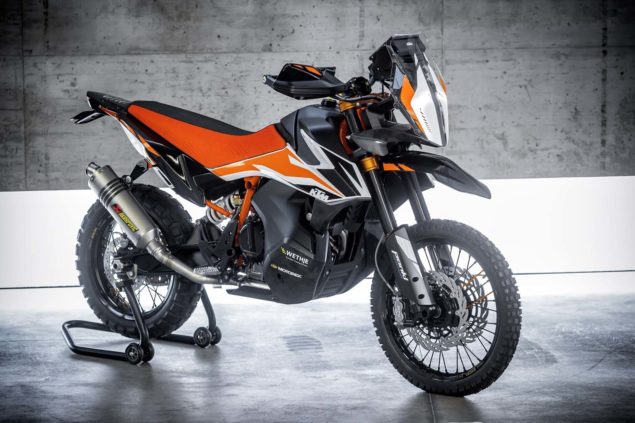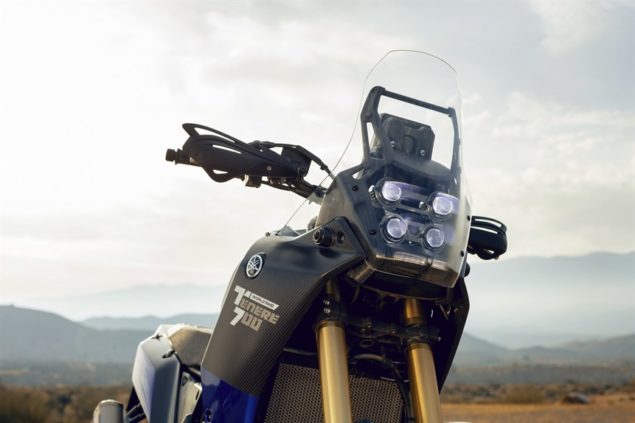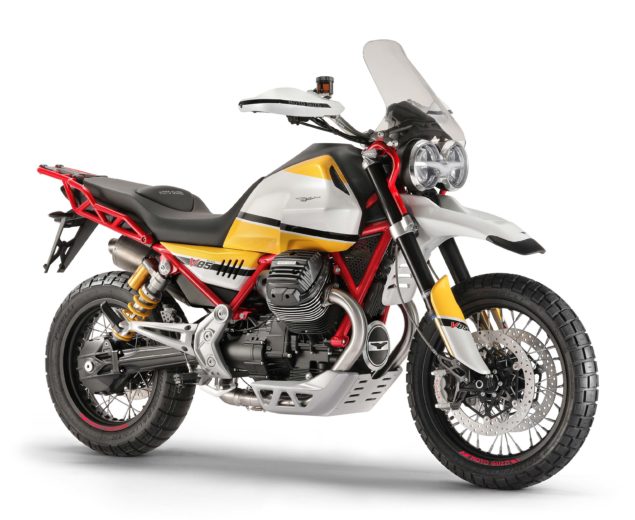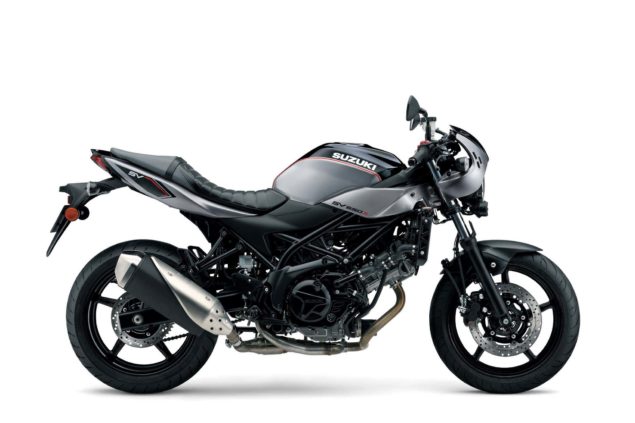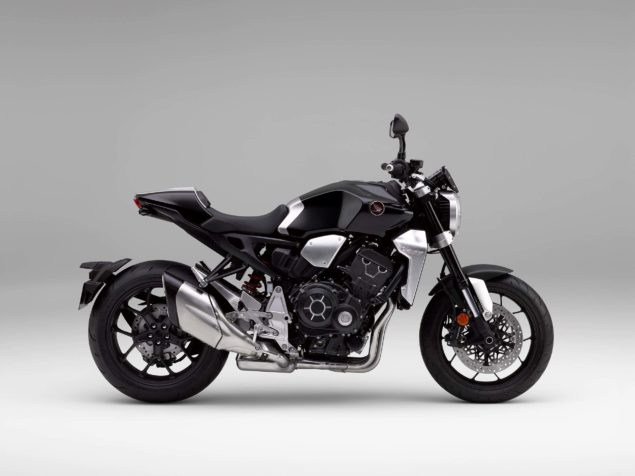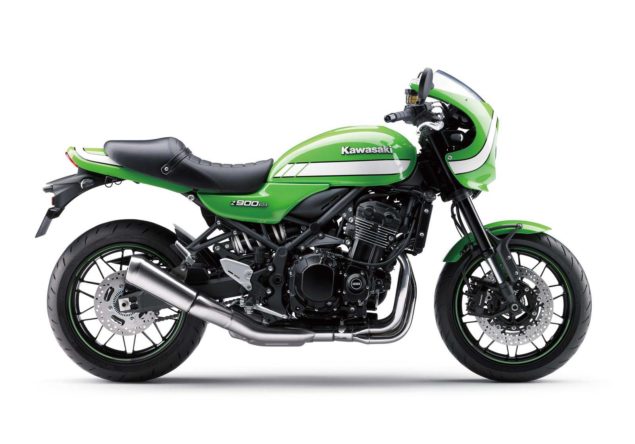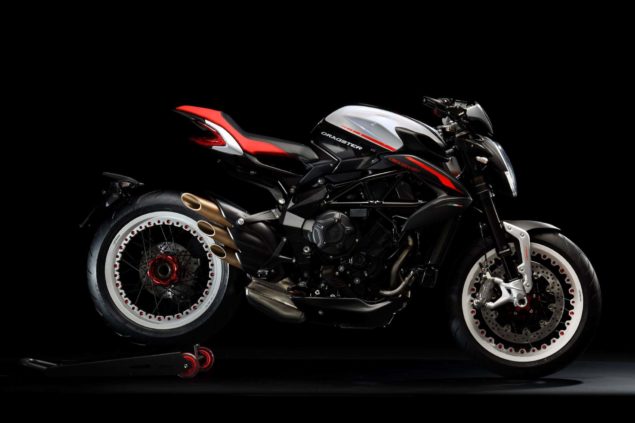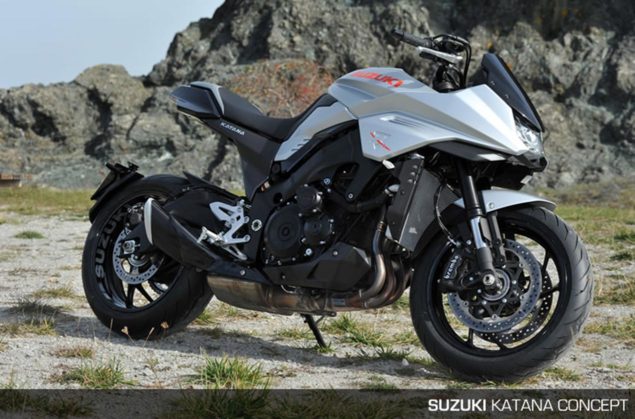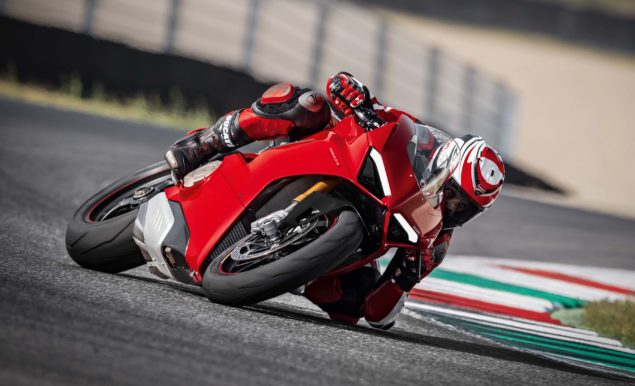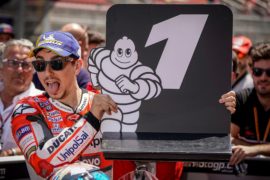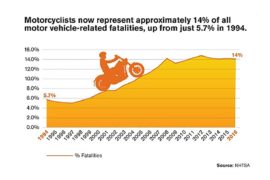The 2017 EICMA show has come and gone, and with it our glimpse at the new motorcycles that will arrive for the next model year, and beyond. EICMA week has always been my Super Bowl, as it culminates the year’s work, and also sets the tone for the upcoming riding season.
Beyond just my limited world though, EICMA sets the trends and the expectations of the motorcycle industry. There is no trade show in our two-wheeled microcosm that has a larger influence than EICMA.
So, while all the new models that we just saw are the week’s big headlines, it is really the trends and movements that will dictate the future of the motorcycle industry.
For this round of the EICMA show, three major trends presented themselves in Milan, along with a few more notable occurrences. Don’t worry, I’ll break them down for you, though it might take a while.
So Many Middleweight ADV Machines
If the 2016 show was all about café racers, especially from the European brands, the 2017 show was all about adventure-tourers – specifically, middleweight ADV machines.
We saw eight new ADV bikes from the motorcycle manufacturers, six of which were squarely in the middleweight category: the BMW F750GS, BMW F850GS, Triumph Tiger 800, KTM 790 Adventure R prototype, Moto Guzzi V85, and Yamaha 700 Ténéré.
What is of note is that half of these middleweight adventure machines were concepts or prototypes. The KTM 790 Adventure R was possibly the bike of the 2017 EICMA show (though Ducati would argue with that, winning the “Peoples’ Choice” award, which is virtually assured to go to an Italian bike every year).
The KTM promises what ADV riders have been screaming for, for years: a lightweight and capable off-road machine, that is still suitable for highway travel. Using the parallel-twin of the KTM 790 Duke, we can expect the KTM 790 Adventure R to debut next year as a production model.
This one-two punch from KTM, with an on-road and off-road 800cc debut, helped distract us from the fact that the Austrian brand had few “new” machines on offer in Milan. Still, KTM was surely the talk of the EICMA show, which bodes well for the brand.
Contrast that reception with Yamaha’s, with the Japanese brand having the balls to trot out another concept/prototype of its upcoming 700cc Ténéré model. While progress has been made since we saw the “T7” concept last year, many expected Yamaha to debut its middleweight ADV bike this year, all ready to go.
The fact that we don’t see a new Yamaha Ténéré 700 for 2018 says a lot about the state of affairs in Iwata, Japan. The adventure-touring market has been a growth sector for the motorcycle industry for almost a decade now, and any brand worth its salt has a multitude of offerings on the table here.
Not Yamaha though.
Offering now only the Super Ténéré to the Western markets – a motorcycle that is good, but by no means competitive with where the segment has gone since the bike’s debut in 2009 – Yamaha is an entirely forgettable brand when it comes to adventure riding.
The lip service given by its EICMA presentation, that the prototype would travel across the world over the next year to ready the production machine, was unconvincing in its authenticity, and was quickly seen through by all.
The reality is, Yamaha is about to become completely irrelevant in the ADV space, and the Japanese brand is hoping to string riders along just long enough that the Ténéré 700 can debut in Fall 2018.
Of course the issue is that by that time, we will already have a glimpse of what is to come for 2019, and most markets will be at the end of their riding season by that point (and thus their selling season too). A full year from its debut, and the Yamaha Ténéré 700 runs the serious risk of being stillborn.
Yamaha’s only hope is that the Ténéré 700 defines the category, and blows expectations out of the water. With an extra year to develop such a machine, any missed target this time next year is entirely the brand’s own fault, and a problem of its own creation.
Not to mention, the Yamaha Ténéré’s first task will be to outshine the KTM 790 Adventure, which will be a tall order.
Less of a threat will be Moto Guzzi, which showed its new V85 platform in the guise of a new Stelvio. Moto Guzzi is very much a brand looking for an identity, and with each passing year, it seems to be Piaggio’s heritage offering.
As such, the Moto Guzzi V85 concept offers what few other ADV bikes can: a mechanically simpler and more vintage approach to the overland lifestyle.
If Moto Guzzi can keep the weight off the new Stelvio, and keep the price tag light as well, this could be a strong option for the anti-establishment crowd, who think that less is more, especially when you are off the beaten path.
I will be very interested to see what Moto Guzzi does in this space, because the Italian brand has an honest chance to wage some asymmetrical warfare on the ADV space, and steal some riders from rival European brands while they are at it.
As for BMW and Triumph, both brands updated their middleweight ADV bikes. There’s no flash, there’s nothing to write home about here, just three mid-cycle refreshes that have been long overdue.
For as many bikes that we saw in this segment, it is surprising how stale the middleweight adventure-touring space is in terms of features and innovations.
There is a real opportunity here for a brand to clean house with a strong product offering, and pick up strong sales from motorcyclists who are known well for their love of farkles.
KTM has seemingly sensed the softness in this space, and it remains to be seen if Yamaha can match their offering.
The 2019 model year should be interesting to watch, and I suspect that without some major updates in the heavyweight ADV sector, we will see these 800cc class bikes stealing some marketshare from there as well.
The Modern Café Racer
We shouldn’t be surprised to see that the café racer trend continues on the manufacturer’s side, though I have thoughts that the movement on the customer side is waning (more on that, at a later date).
What is interesting to note though is the trend to use modern platforms for these “post-authentic” motorcycles. The Honda CB1000R, Husqvarna Vitpilen 701, Kawasaki Z900RS Cafe, and Suzuki SV650X are all new models that are built upon existing, more modern, machines.
From this spectrum of entrants, we see varying degrees of effort, which should predict success at the dealership level.
On one end of the spectrum is the Suzuki SV650X. Built upon a motorcycle that I would argue is one of the greatest motorcycles ever built, but the SV650X does little to offering a more heritage blend to the venerable SV650.
The result feels half-baked, and very much a “me too” addition to the space. I suspect that the Suzuki SV650X will get about the same response as the Yamaha SCR950, another woefully tarted-up motorcycle that hopes to appeal to the young hipster crowd, but so obviously fails at that stated goal.
Conversely, no machine more thoroughly impressed us at the EICMA show than the new Honda CB1000R.
A motorcycle that has so faithfully been a disappoint in the streetfighter segment, the retro-modern take on this repurposed CBR1000R hits the nail on the head this time around, by being both alluring and different.
Before the Honda CB1000R debuted, it would be easy to write-off Honda and its design team for tendency to make uninspiring motorcycles – reference the entire NC and VFR lineups – but the “Neo Sports Café” aesthetic is a fresh take, and one that we would not expect from a Japanese brand.
It is nice to be surprised sometimes.
Another strong entry is the Kawasaki Z900RS Cafe, which adds a bikini fairing to the already unveiled Z900RS model. Based on the well-regarded Z900 platform, both of these motorcycles should be potent and powerful street bikes.
While the Honda CB1000R is a bit more futuristic, Kawasaki has nailed the vintage/heritage look perfectly with its two new Z900s. For those wanting to look the retro part, but still have the mechanics of a modern sport bike, this is the perfect offering.
The big loser in all of this…I mean, besides Suzuki…might be Husqvarna. Finally bringing the Vitpilen 701 as a production model, the Swedish brand now has to contend with a bevy of other options in the space, all the while its design loses its freshness from its long wait in the design studio.
As I suspect will be the case with the Yamaha Ténéré 700, Husqvarna’s failure to bring the Vitpilen 701 to market in a timely manner might be its undoing.
The Husqvarna Vitpilen 701 promises to be a great sport bike to ride, and I have already said how I’m a fan of the modern-retro aesthetic, but the momentum of Husqvarna’s street bike lineup has been woefully squandered by the brand’s inability to bring bikes to market for consumers.
Couple that to the Husqvarna Svartpilen 701 concept, which also feels out of place, and I get the feeling that Husqvarna’s street bike arsenal is just late to the party.
KTM had this same issue with the RC8 superbike, a superb machine, but wholly irrelevant by the time it landed on dealership floors. I worry that the Austrians haven’t learned from this mistake, and are about to repeat it.
This is a shame, because I cannot think of a series of motorcycles that were more warmly regarded and eagerly anticipated than the original Vitpilen and Svartpilen concepts.
The No-Shows
The only thing more disappointing to the bikes that are slow to come to market are those that never show-up in the first place. On that note, the 2017 EICMA show had a surprising number of no-shows, in terms of new models from OEMs.
One of the most obvious to my eyes was the complete absence of Bimota, who despite their insistence that they are very much still in business, continued to seem anything but.
Not only did the historic Italian brand not have a new model to show the EICMA crowd, Bimota didn’t even have a both. Troubling, indeed.
Along the same vein was MV Agusta, which seemingly walks back its promises with each interaction.
First, we were told that a new F4 superbike was just around the corner. Then, MV Agusta would have two new bikes for 2018, said the company. Next, it was a new Brutale four-cylinder, as the F4 was to expensive to develop…
What we ended up with for the 2018 model year was a bevy of updates to the lineup, mostly for Euro4 homologation. As such, say hello to the 2018 MV Agusta Brutale Dragster 800 RR (say that three times fast).
It’s an attractive machine, sure, but it shows just how deeply MV Agusta is reeling from its financial troubles, Russian investments or not.
At this point, we can only hope for some late model year debuts, as the coffers at MV Agusta fill with investment, and R&D moves forward on new model launches.
Similar in its presence, but lack of presentation was Suzuki, which only offered the SV650X for our new-model product lust. Surprisingly, one of the most interesting motorcycles at EICMA wasn’t even hyped by the PR folk, and it was a Suzuki.
Showing what it called a “Katana 3.0” concept in its booth, Suzuki gave an insight into one of the most recognizable street bike brands.
With the 1980s showing themselves to be the new custom trend, and Suzuki’s endurance racing Katana getting plenty of attention, there seems to be fire left in the Katana name…if only Suzuki could breathe some life into it.
We are long overdue to see a production version of Suzuki’s Recursion Concept, and there is talk that it could be the basis for a new turbocharged Katana. At this point, I would take whatever I can get.
My sources tell me of great and interesting bikes in Suzuki’s development pipe, but the Japanese brand needs to show some signs of life. It has a range of motorcycles that were benchmarks in their day, but few (if any at all) lead their category now.
The Suzuki brand desperately needs a win. It needs a bike that will get people interested and excited about this once dominant marque. Otherwise, I have a legitimate worry that the “Big Four” in the motorcycle industry will become the “Big Three”.
Other Items
The so-called “Peoples’ Choice” of EICMA is perhaps the model that missed the mark the most. I am of course talking about the Ducati Panigale V4. What will surely be an amazing motorcycle to ride, the Panigale V4 might be proof that Ducati has lost its way as a brand.
I am actually fine with Ducati abandoning its v-twin superbike platform. This is because I like everything that a 90° desmodromic V4 engine has to offer me as a motorcyclist.
What the Panigale V4 is missing though, is right there in its name. The move from v-twin to V4 seems to be less of an issue for Ducatisti than perhaps those in Bologna thought. Instead, it is the company’s tepid movement with this new superbike that seems to be issue.
Good leadership knows to capitalize on a crack in time, and a V4 Ducati is certainly such an instance…such a defining moment. Instead of being punctuated by a new radical design, some new model that captivates both hemispheres of our split brains, Ducati appealed only to our practical senses.
The Panigale V4’s biggest weakness is that it looks so similar to its predecessor. The similarities are so strong, Ducati felt compelled to keep the name intact. Even a last-minute touching to the bike’s fairing shapes couldn’t hide the fact that this was a design recycling.
Early indications on pricing show the Ducati Panigale V4 to be incredibly expensive as well. Maybe a machine with more product lust could command such a premium, but I think Ducati misjudged not only its product, but also the market.
I see more and more Aprilia RSV4 superbikes at my track days, and I don’t think that is an accident.
If there seems to be rain cloud over this article’s tone, the silver-lining of sunshine has to be the Indian Scout FTR1200. Called a “tribute bike” by the American manufacturer, the concept hints at a street tracker soon to come.
I have been behind this idea for quite some time, offering it as a way for Harley-Davidson to stay relevant with younger buyers, and suggesting it as a way for Victory to redefine itself for the 21st century. So, it is good to see Indian finally take up the mantle.
It is not clear when (that is assuming we get past the “if”) the Scout FTR1200 goes into production. One has to consider too what the production model would look like. Would it keep the bespoke lightweight chassis? Or, would the pork monster that is the Indian Scout have too much influence?
A sub-500 lbs motorcycle is a must here, and hopefully Indian realizes that. Truthfully, what we really want isn’t a bike like the FTR1200…we want the 750cc water-cooled Indian Scout FTR750…with lights and license plate.
We want a true performance bike, not just another tarted up cruiser. I have very little doubt that Indian will produce a street tracker model, but what that bike looks like, and how Indian produces it, will tell a lot about the brand and the people behind it. Fingers crossed.
Up or Down?
My last takeaway from the EICMA show was how much of the show was about updated models, rather than new ones. The number of debuts felt smaller too, in part because of how much importance the Japanese brands gave the Tokyo Motor Show this year, but also in total.
The motorcycle industry has not rebounded from the global recession like many thought it would – certainly not so in the United States, as we are about to see yearly sales figures that are solidly lower than last year’s numbers.
I worry that this points to another contraction from the motorcycle industry, with brands already battening down the hatches by releasing strategic updates, rather than new models.
Take note too of Yamaha’s foray with the Yamaha Niken. I can think of no better proof that OEMs are hedging their bets on motorcycles, than Yamaha’s three-wheeled experiment.
Hopefully 2018 feels more like winning than 2017 did, but it is hard to be optimistic at this point.
You find links to all the bikes we covered at the 2017 EICMA show right here.

